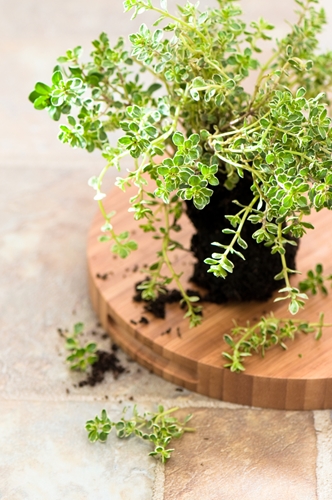Know Your Herbs

Adding the right herbs can make all the difference between a meal that is serviceably filling but bland and one that is exceptionally delicious. Plus, herbs offer a method of adding flavor that is considerably healthier than smothering your food with fat or salt. Being aware of the primary uses of some of the most common herbs and eventually improvising new taste combinations are major steps in learning to cook.
The essentials
Having a wide array of herbs in your kitchen opens up endless possibilities for your cooking. However, first you need to understand the basics. Here are just some of the herbs found in most cooks’ kitchens:
- Parsley contributes a mild, grassy flavor to pasta, meat, eggs or fish.
- Cooling mint serves well in sweets, but it also complements savory dishes like lamb.
- Aromatic and sweet, basil is great in a tomato sauce or pesto.
- Bay leaves reduce bitterness, giving soups and stews a woody flavor. However, you should always remove them before serving as they are stiff and scratchy.
- Rosemary has spiky leaves with a strong, pine-like taste that, in moderation, goes well with tomato sauce, garlic or olive oil.
- You can add thyme to nearly any kind of meat, vegetable or fish for a minty flavor that pairs well with other spices.
- Sage has a powerful flavor, especially when dried, but it can be excellent as part of a traditional turkey stuffing or a complement to brown butter.
- Peppery, sweet oregano is essential for Mediterranean and Mexican foods, and is a good addition to almost any kind of pasta or meat.
- Use chives for a mildly onion-like effect in potato, risotto or cream sauces or just to add an attractive garnish.
- The pungent and unmistakable taste of cilantro gives a kick to tacos, chicken, salsa or curry.
- Dill is an aromatic herb that makes a great addition to salmon or a stew or mixed with vegetables like carrots or cucumbers.
 Storing or drying herbs
Storing or drying herbs
By keeping your herbs correctly stored, you will always have the flavors you want at the ready. Martha Stewart advised wrapping herbs in a paper towel and placing them in resealable plastic bags before refrigerating them. Some herbs, like sage or rosemary, will keep for up to a week in the refrigerator without diminishing their fragrance or color.
However, tender, fragile herbs like basil, dill, cilantro or tarragon require further care to retain freshness. Fine Cooking recommended immediately taking off any fasteners or rubber bands holding a bunch of these herbs together when you bring them home. Then, trim off the ends of roots or stems. Otherwise, the leaves will lose moisture, causing them to wilt.
That said, while fresh herbs are usually preferable, some, such as oregano and sage, add potently concentrated flavor to your food when dried. Dried herbs are readily available at grocery stores, but you can achieve tastier results by preparing your own. Bon Appetit explained that you should first bundle the herbs together by their stems with a piece of twine. Hang them upside down in a dry place that receives plenty of light, such as a window. In a week, try crumbling a couple leaves to see if they have in fact dried out. Make sure the herbs are fully dry before jarring them for later use in cooking or you risk forming mold in the jar. If you like, you can preserve the herbs longer by infusing them into a salt or sugar for use in cooking, grilling or baking.
Chopping herbs
Thoughtlessly cutting up herbs leads to bruising the leaves and wasting usable portions. Epicurious suggested cleaning your herbs by placing them in a sink filled with cold water and moving them about gently to remove any dirt. Shake water from the herbs or use a salad spinner and then set them on a towel to finish drying. Once they are entirely dry, you can begin cutting.
- To prepare dill, cilantro or parsley, begin by removing the thick base of the stem. The thinner portions are perfectly edible and tasty, so chop the stem along with the leaves.
- Remove mint, sage or basil leaves from their stems and tear them into pieces by hand to avoid bruising.
- Thyme, oregano and rosemary call for grasping a sprig at the top, pinching the stem and then running your fingers downward. This will remove the leaves, which you will then pile up and cut down to size.






Recent Comments